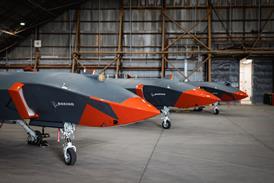The US Army is investing in major upgrades to its existing rotary-wing aviation fleet, including a new electronic warfare capability and the latest encrypted communications systems.
Lockheed Martin is under contract to develop a new radar warning receiver for the army’s fleet of Boeing AH-64E Apache attack helicopters. The company on 15 October said it will develop a third generation of the AN/APR-48B radar frequency interferometer (RFI) that is currently in service with the Apache fleet.

That system performs target acquisition and cueing for the AH-64E’s fire-control radar, while also warning aviators about the presence of radar-directed anti-aircraft threats on the battlefield – at a time when army leaders are increasingly seeking to counter threats posed by precision munitions.
“The Gen 3 RFI system will provide significant capability enhancements that are enabled by advanced micro-electronics,” Lockheed says, noting the system will come in a smaller, lighter package.
The company does not disclose the value of the contract, which covers development, production and qualification of the Gen 3 RFI system.
Also on 15 October, the army awarded BAE Systems a contract worth up to $460 million to upgrade the service’s rotary-wing fleet with new encrypted radios.
BAE says the AN/ARC-231/A Multi-mode Aviation Radio Set (MARS) is a multi-band encrypted system that offers a range of communication options including anti-jam voice, data imagery and network transmissions.
“This airborne radio design enables the US Army to upgrade their rotary-wing fleet with the latest secure waveform that can be tailored for each mission for years to come,” says Amber Dolan, director of adaptive communications and sensing for BAE Systems.
BAE also says it completed delivery of missile warning systems to US Army.
Designed and produced by BAE under the army’s Limited Interim Missile Warning System programme, the 2-Color Advanced Warning Systems (2CAWS) is intended to improve survivability for all army rotorcraft, including the Boeing CH-47 heavy-lift, Sikorsky UH-60 utility and AH-64 attack helicopters.
BAE delivered 400 of the threat-detection systems, which the company says use multi-spectral sensors and machine learning algorithms to detect incoming hazards and cue laser-based and expendable countermeasures.
“We’ve worked closely with army aviation to provide cutting-edge capabilities that protect crews from evolving threats, provide adversarial over-match, and enable war fighters to execute missions in contested battlespace,” says Dave Harrold, general manager of countermeasure and electromagnetic attack solutions at BAE.
The company says 2CAWS-equipped aircraft have successfully flown thousands of hours in operational environments. BAE also produces the older Common Missile Warning System, which is in service on aircraft operated by the US Army and international partners.
















































